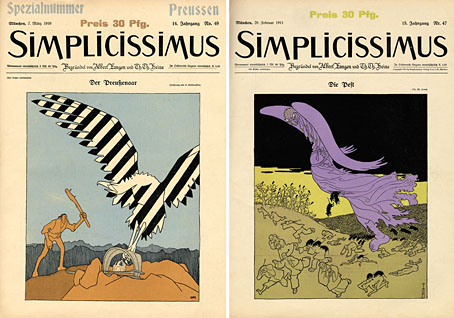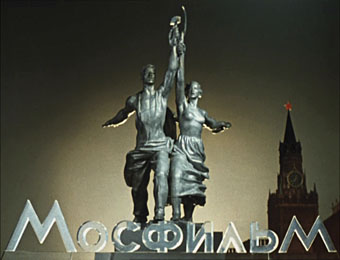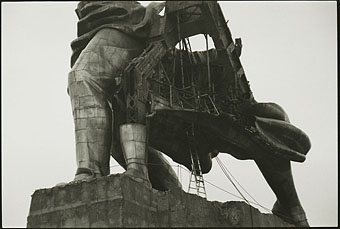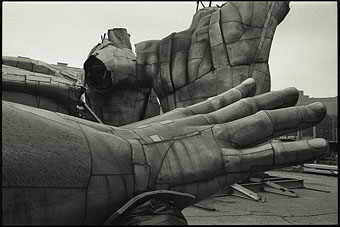Four years of war in Iraq.
And counting…
Category: {politics}
Politics
Simplicissimus
Every issue of the weekly German satire magazine—from 1896 to 1944—is available for download as a free PDF here. Amazing.
Combining brash and politically daring content, a bright, immediate, surprisingly modern graphic style, Simplicissimus featured the work of German cartoonist Thomas Theodor Heine on every cover, and published the work of writers such as Thomas Mann and Rainer Maria Rilke. Its most reliable targets for caricature were stiff Prussian military figures, and rigid German social and class distinctions as seen from the more relaxed, liberal atmosphere of Munich.
Yes, the content is in German but Simplicissimus, like Punch, featured cartoons (some in strip form) and illustrations as well. Each issue also includes a couple of pages of adverts that are fun to look at. Lots of samples from its visual contributors, including the great Heinrich Kley, here. Via Design Observer.
Previously on { feuilleton }
• Revenant volumes: Bob Haberfield, New Worlds and others
• 100 Years of Magazine Covers
• It’s a pulp, pulp, pulp world
• Vintage magazine art II
• The art of Heinrich Kley, 1863–1945
• Neville Brody and Fetish Records
• View: The Modern Magazine
• Vintage magazine art
• Oz magazine, 1967–73
The Trap by Adam Curtis
Adam Curtis, producer of brilliant documentary series such as Pandora’s Box, The Century of the Self and The Power of Nightmares, has a new series starting on BBC 2 next week. The Guardian profiled him and his work today. The Power of Nightmares is available to download here.
Cry freedom
In the cold war paranoia made sense, but a bold new documentary argues that the west has become trapped in a false idea of what it means to be human. By Oliver Burkeman
Oliver Burkeman
The Guardian, Saturday March 3, 2007
IN THE MID-1950s, with the cold war growing chillier, paranoia seeped through the corridors of the Rand Corporation, the fabled military thinktank in California. After all, to the hotshot young analysts paid to devise America’s strategy in the nuclear standoff with Moscow, paranoia seemed to make perfect sense. If you assumed that you couldn’t trust your enemy—and you assumed that your enemy felt the same about you—then whatever noises you made about disarmament, you’d always stockpile weapons, because you’d assume your enemy was doing the same. Nobody would dare attack, and an edgy stability would result. Act with trust and co-operation, on the other hand, and you risked a situation where both sides would claim to be willing to disarm, but then only you actually did so, spelling instability, then doom.
This was what the thinktank’s logicians called the “prisoner’s dilemma”, and the more ambitious among them—inspired by John Nash, the mathematical genius and Rand Corporation scholar portrayed by Russell Crowe in the film A Beautiful Mind—had high hopes for their newborn theory. Could it be, they wondered, that stability in everyday human relations was achieved by the same kind of self-centred suspicion and distrust? To test their ideas, they recruited the nearest everyday humans they could find: the Rand Corporation’s secretaries. In experiments, they posed various dilemmas for pairs of secretaries, in which they could co-operate or betray each other. (A typical question involved the purchase of a Buick; one imagines women in knee-length dresses, gamely tolerating questions from clipboard-wielding men in horn-rimmed glasses and short-sleeved shirts.) The theory predicted they’d choose betrayal, because they couldn’t trust the other one not to. Every single time, however, they chose to co-operate.
Perhaps if the analysts had paid more attention to their secretaries, the history of the past half-century would have proved very different. Instead, according to a new documentary series beginning on BBC2 next weekend, the paranoid theories hatched during the cold war would come to inspire a peculiar, cold-hearted idea of personal freedom—one that helps explain everything from the rise of Prozac and Viagra to Labour’s obsession with healthcare targets, from the military crusades of George Bush and the rise of the Iraqi insurgency to the rampant diagnosis of attention deficit disorder in children.
Dead monuments
Anyone who’s seen a Soviet film from 1947 onwards will recognise the logo of the Mosfilm studio which featured a model of Vera Mukhina’s Worker and Kolkhoz Woman monument. This 24-metre tall steel-plate statue proved surplus to requirements after the collapse of the old order, like so many monuments of that period. English Russia has a series of moody photographs of the structure lying in pieces whilst being dismantled.
Poor Vera, who died in 1953, must have thought her work would last a very long time; these pictures are a poignant reminder of the ephemeral nature, not only of art, but of whole ideologies. They’re also reminiscent of the deliberately degraded sculptures made by Igor Mitoraj (below) which trade for their effect on exactly this disjunction between delusions of permanence and the ravages of history.
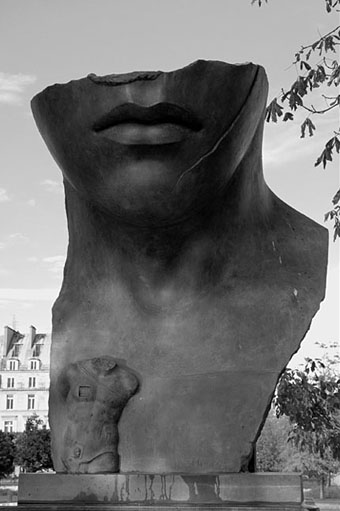
And on these Flickr pages you can see one of Mitoraj’s influences from a ravaged past, the fragments of the Colossal Statue of Constantine in the Palazzo dei Conservatori, Rome.
Previously on { feuilleton }
• The Stalker meme
• The art of Igor Mitoraj
• Enormous structures II: Tatlin’s Tower
• Solaris
Kropotkin in TIME
Kropotkin in TIME.
Open-source anarchism.

